boot FIAT FIORINO 2007 Owner handbook (in English)
[x] Cancel search | Manufacturer: FIAT, Model Year: 2007, Model line: FIORINO, Model: FIAT FIORINO 2007Pages: 210, PDF Size: 3.22 MB
Page 5 of 210

4
SAFETY
STARTING
AND DRIVING
WARNING
LIGHTS AND
MESSAGES
IN AN
EMERGENCY
MAINTENANCE
AND CARE
TECHNICAL
SPECIFICATIONS
INDEX
DASHBOARD
AND CONTROLSDASHBOARD........................................................................ 5
INSTRUMENT PANEL......................................................... 6
SYMBOLS ............................................................................... 7
THE FIAT CODE SYSTEM ................................................. 7
THE KEYS .............................................................................. 8
ALARM ................................................................................... 12
IGNITION DEVICE ............................................................. 14
INSTRUMENTS .................................................................... 15
DIGITAL DISPLAY ............................................................... 17
MULTIFUNCTIONAL DISPLAY ...................................... 22
TRIP COMPUTER ................................................................ 31
SEATS ...................................................................................... 33
PARTITIONS.......................................................................... 36
HEAD RESTRAINTS............................................................. 38
STEERING WHEEL .............................................................. 39
REARVIEW MIRRORS......................................................... 39
HEATING AND CLIMATE CONTROL SYSTEM ........ 41
HEATING AND VENTILATION...................................... 43
MANUAL CLIMATE CONTROL SYSTEM .................... 46EXTERNAL LIGHTS ............................................................ 49
WINDOW WASHING....................................................... 51
CEILING LIGHTS.................................................................. 53
CONTROLS........................................................................... 56
INTERIOR FITTINGS........................................................... 58
DOORS .................................................................................. 61
WINDOW WINDERS ....................................................... 66
BOOT ...................................................................................... 67
BONNET................................................................................. 70
ROOF RACK/SKI RACK .................................................... 72
HEADLIGHTS........................................................................ 73
ABS SYSTEM ......................................................................... 74
EOBD SYSTEM ..................................................................... 76
PARKING SENSORS ........................................................... 77
SOUND SYSTEM.................................................................. 79
ELECTRICAL/ELECTRONIC DEVICES
INSTALLATION.................................................................... 80
VEHICLE REFUELLING........................................................ 81
ENVIRONMENTAL PROTECTION................................. 82
DD D
A A
S S
H H
B B
O O
A A
R R
D D
A A
N N
D D
C C
O O
N N
T T
R R
O O
L L
S S
Page 13 of 210
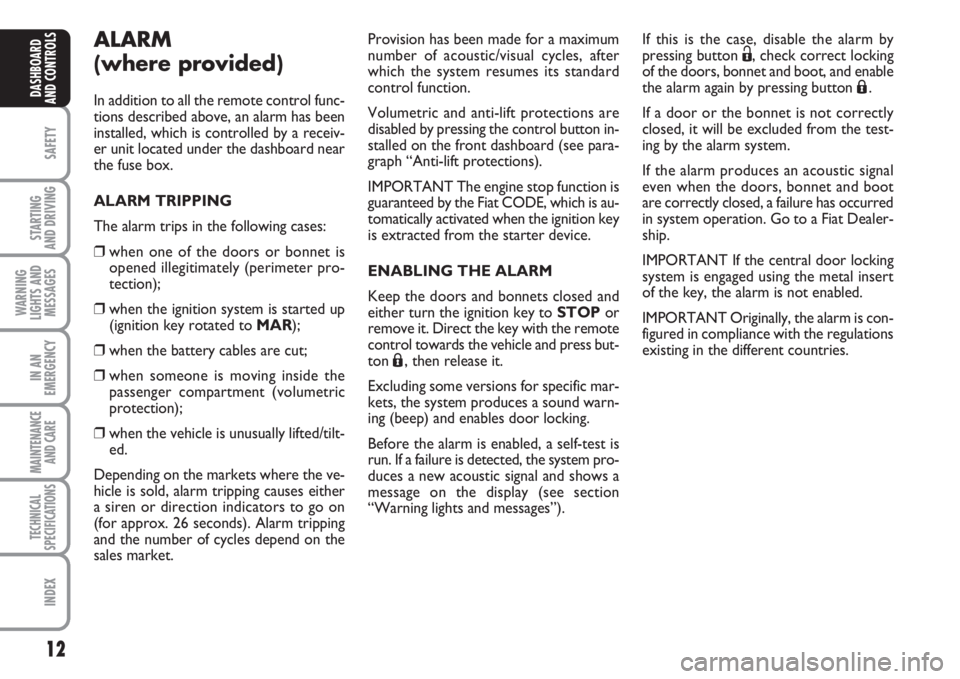
12
SAFETY
STARTING
AND DRIVING
WARNING
LIGHTS AND
MESSAGES
IN AN
EMERGENCY
MAINTENANCE
AND CARE
TECHNICAL
SPECIFICATIONS
INDEX
DASHBOARD
AND CONTROLS
ALARM
(where provided)
In addition to all the remote control func-
tions described above, an alarm has been
installed, which is controlled by a receiv-
er unit located under the dashboard near
the fuse box.
ALARM TRIPPING
The alarm trips in the following cases:
❒when one of the doors or bonnet is
opened illegitimately (perimeter pro-
tection);
❒when the ignition system is started up
(ignition key rotated to MAR);
❒when the battery cables are cut;
❒when someone is moving inside the
passenger compartment (volumetric
protection);
❒when the vehicle is unusually lifted/tilt-
ed.
Depending on the markets where the ve-
hicle is sold, alarm tripping causes either
a siren or direction indicators to go on
(for approx. 26 seconds). Alarm tripping
and the number of cycles depend on the
sales market.Provision has been made for a maximum
number of acoustic/visual cycles, after
which the system resumes its standard
control function.
Volumetric and anti-lift protections are
disabled by pressing the control button in-
stalled on the front dashboard (see para-
graph “Anti-lift protections).
IMPORTANT The engine stop function is
guaranteed by the Fiat CODE, which is au-
tomatically activated when the ignition key
is extracted from the starter device.
ENABLING THE ALARM
Keep the doors and bonnets closed and
either turn the ignition key to STOPor
remove it. Direct the key with the remote
control towards the vehicle and press but-
ton
Á, then release it.
Excluding some versions for specific mar-
kets, the system produces a sound warn-
ing (beep) and enables door locking.
Before the alarm is enabled, a self-test is
run. If a failure is detected, the system pro-
duces a new acoustic signal and shows a
message on the display (see section
“Warning lights and messages”). If this is the case, disable the alarm by
pressing button Ë, check correct locking
of the doors, bonnet and boot, and enable
the alarm again by pressing button
Á.
If a door or the bonnet is not correctly
closed, it will be excluded from the test-
ing by the alarm system.
If the alarm produces an acoustic signal
even when the doors, bonnet and boot
are correctly closed, a failure has occurred
in system operation. Go to a Fiat Dealer-
ship.
IMPORTANT If the central door locking
system is engaged using the metal insert
of the key, the alarm is not enabled.
IMPORTANT Originally, the alarm is con-
figured in compliance with the regulations
existing in the different countries.
Page 68 of 210
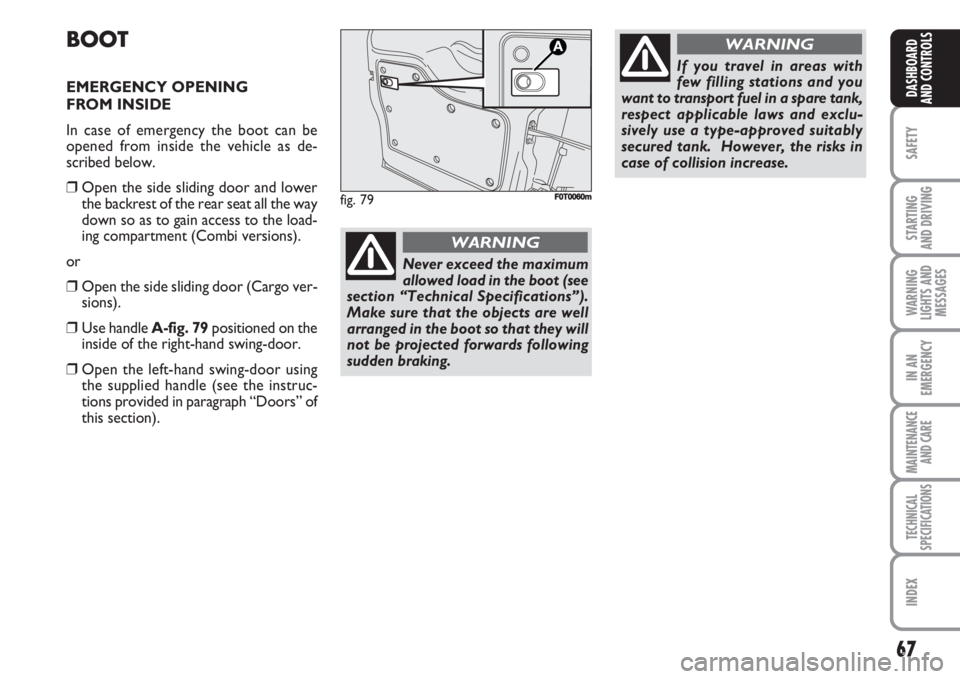
67
SAFETY
STARTING
AND DRIVING
WARNING
LIGHTS AND
MESSAGES
IN AN
EMERGENCY
MAINTENANCE
AND CARE
TECHNICAL
SPECIFICATIONS
INDEX
DASHBOARD
AND CONTROLS
BOOT
EMERGENCY OPENING
FROM INSIDE
In case of emergency the boot can be
opened from inside the vehicle as de-
scribed below.
❒Open the side sliding door and lower
the backrest of the rear seat all the way
down so as to gain access to the load-
ing compartment (Combi versions).
or
❒Open the side sliding door (Cargo ver-
sions).
❒Use handle A-fig. 79positioned on the
inside of the right-hand swing-door.
❒Open the left-hand swing-door using
the supplied handle (see the instruc-
tions provided in paragraph “Doors” of
this section).
fig. 79F0T0060m
Never exceed the maximum
allowed load in the boot (see
section “Technical Specifications”).
Make sure that the objects are well
arranged in the boot so that they will
not be projected forwards following
sudden braking.
WARNING
If you travel in areas with
few filling stations and you
want to transport fuel in a spare tank,
respect applicable laws and exclu-
sively use a type-approved suitably
secured tank. However, the risks in
case of collision increase.
WARNING
Page 70 of 210
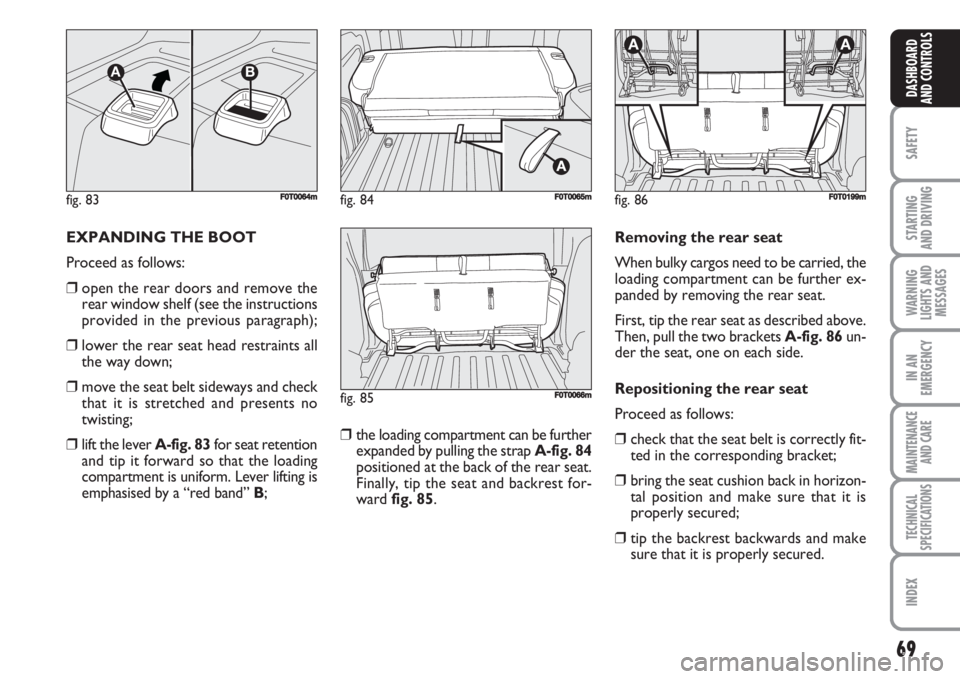
69
SAFETY
STARTING
AND DRIVING
WARNING
LIGHTS AND
MESSAGES
IN AN
EMERGENCY
MAINTENANCE
AND CARE
TECHNICAL
SPECIFICATIONS
INDEX
DASHBOARD
AND CONTROLS
EXPANDING THE BOOT
Proceed as follows:
❒open the rear doors and remove the
rear window shelf (see the instructions
provided in the previous paragraph);
❒lower the rear seat head restraints all
the way down;
❒move the seat belt sideways and check
that it is stretched and presents no
twisting;
❒lift the lever A-fig. 83for seat retention
and tip it forward so that the loading
compartment is uniform. Lever lifting is
emphasised by a “red band” B;❒the loading compartment can be further
expanded by pulling the strap A-fig. 84
positioned at the back of the rear seat.
Finally, tip the seat and backrest for-
ward fig. 85.Removing the rear seat
When bulky cargos need to be carried, the
loading compartment can be further ex-
panded by removing the rear seat.
First, tip the rear seat as described above.
Then, pull the two brackets A-fig. 86un-
der the seat, one on each side.
Repositioning the rear seat
Proceed as follows:
❒check that the seat belt is correctly fit-
ted in the corresponding bracket;
❒bring the seat cushion back in horizon-
tal position and make sure that it is
properly secured;
❒tip the backrest backwards and make
sure that it is properly secured.
fig. 83
AB
F0T0064mfig. 84F0T0065m
fig. 85F0T0066m
fig. 86
AA
F0T0199m
Page 71 of 210
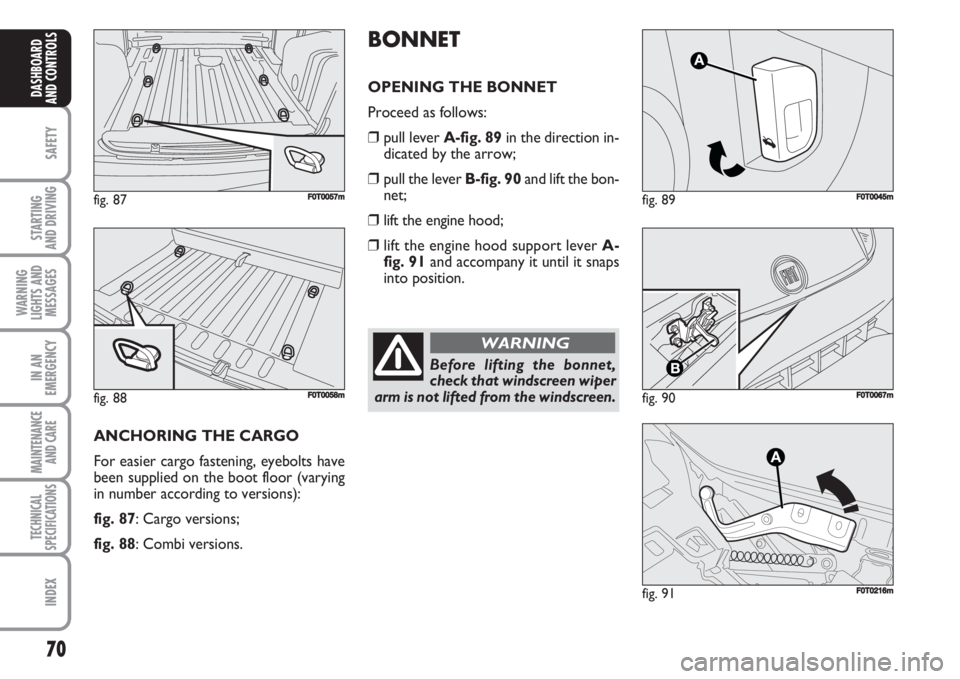
70
SAFETY
STARTING
AND DRIVING
WARNING
LIGHTS AND
MESSAGES
IN AN
EMERGENCY
MAINTENANCE
AND CARE
TECHNICAL
SPECIFICATIONS
INDEX
DASHBOARD
AND CONTROLS
fig. 89FF0T0045m
fig. 90F0T0067m
Before lifting the bonnet,
check that windscreen wiper
arm is not lifted from the windscreen.
WARNING
ANCHORING THE CARGO
For easier cargo fastening, eyebolts have
been supplied on the boot floor (varying
in number according to versions):
fig. 87: Cargo versions;
fig. 88: Combi versions.
BONNET
OPENING THE BONNET
Proceed as follows:
❒pull lever A-fig. 89in the direction in-
dicated by the arrow;
❒pull the lever B-fig. 90and lift the bon-
net;
❒lift the engine hood;
❒lift the engine hood support lever A-
fig. 91and accompany it until it snaps
into position.
fig. 87F0T0057m
fig. 88F0T0058m
fig. 91
A
F0T0216m
Page 73 of 210
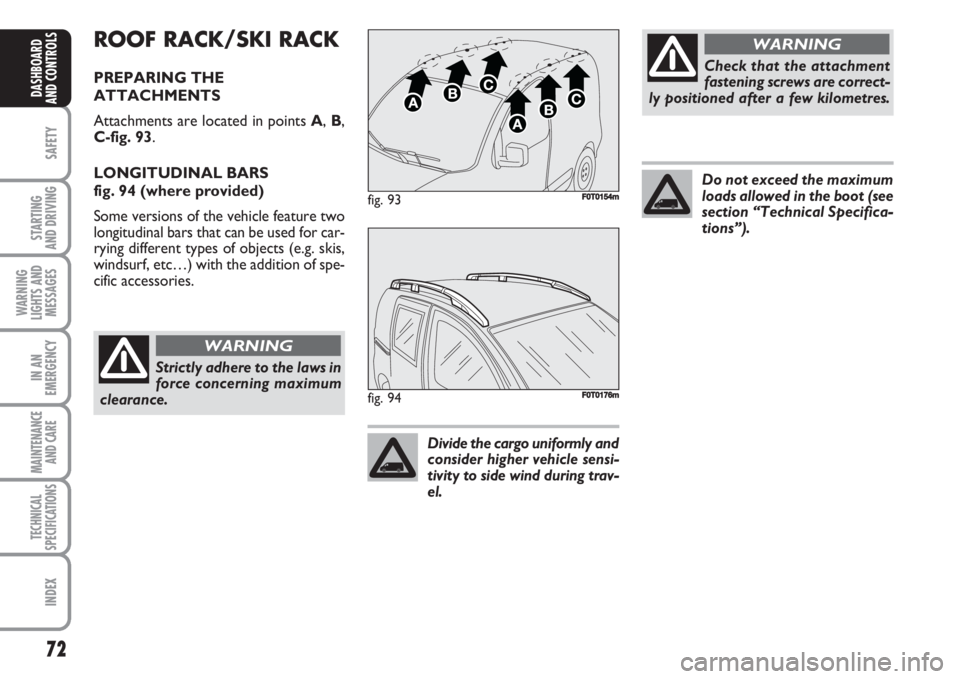
72
SAFETY
STARTING
AND DRIVING
WARNING
LIGHTS AND
MESSAGES
IN AN
EMERGENCY
MAINTENANCE
AND CARE
TECHNICAL
SPECIFICATIONS
INDEX
DASHBOARD
AND CONTROLS
ROOF RACK/SKI RACK
PREPARING THE
ATTACHMENTS
Attachments are located in points A,B,
C-fig. 93.
LONGITUDINAL BARS
fig. 94 (where provided)
Some versions of the vehicle feature two
longitudinal bars that can be used for car-
rying different types of objects (e.g. skis,
windsurf, etc…) with the addition of spe-
cific accessories.
fig. 93F0T0154m
fig. 94F0T0176m
Strictly adhere to the laws in
force concerning maximum
clearance.
WARNING
Check that the attachment
fastening screws are correct-
ly positioned after a few kilometres.
WARNING
Divide the cargo uniformly and
consider higher vehicle sensi-
tivity to side wind during trav-
el.
Do not exceed the maximum
loads allowed in the boot (see
section “Technical Specifica-
tions”).
Page 74 of 210
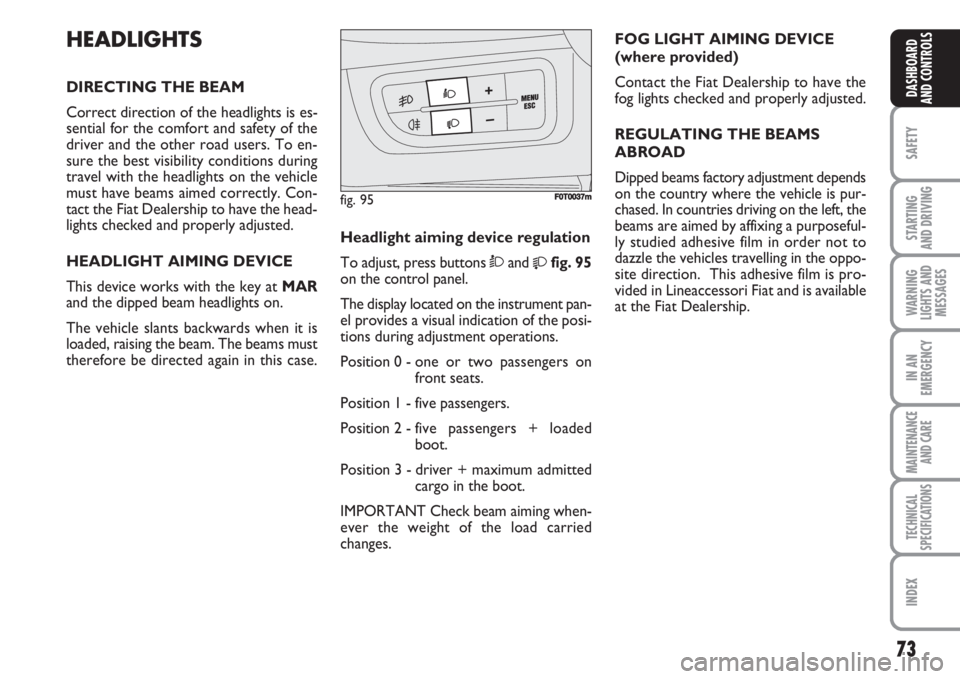
73
SAFETY
STARTING
AND DRIVING
WARNING
LIGHTS AND
MESSAGES
IN AN
EMERGENCY
MAINTENANCE
AND CARE
TECHNICAL
SPECIFICATIONS
INDEX
DASHBOARD
AND CONTROLS
HEADLIGHTS
DIRECTING THE BEAM
Correct direction of the headlights is es-
sential for the comfort and safety of the
driver and the other road users. To en-
sure the best visibility conditions during
travel with the headlights on the vehicle
must have beams aimed correctly. Con-
tact the Fiat Dealership to have the head-
lights checked and properly adjusted.
HEADLIGHT AIMING DEVICE
This device works with the key at MAR
and the dipped beam headlights on.
The vehicle slants backwards when it is
loaded, raising the beam. The beams must
therefore be directed again in this case.Headlight aiming device regulation
To adjust, press buttons Òand
fig. 95
on the control panel.
The display located on the instrument pan-
el provides a visual indication of the posi-
tions during adjustment operations.
Position 0 - one or two passengers on
front seats.
Position 1 - five passengers.
Position 2 - five passengers + loaded
boot.
Position 3 - driver + maximum admitted
cargo in the boot.
IMPORTANT Check beam aiming when-
ever the weight of the load carried
changes.FOG LIGHT AIMING DEVICE
(where provided)
Contact the Fiat Dealership to have the
fog lights checked and properly adjusted.
REGULATING THE BEAMS
ABROAD
Dipped beams factory adjustment depends
on the country where the vehicle is pur-
chased. In countries driving on the left, the
beams are aimed by affixing a purposeful-
ly studied adhesive film in order not to
dazzle the vehicles travelling in the oppo-
site direction. This adhesive film is pro-
vided in Lineaccessori Fiat and is available
at the Fiat Dealership.
fig. 95F0T0037m
Page 95 of 210
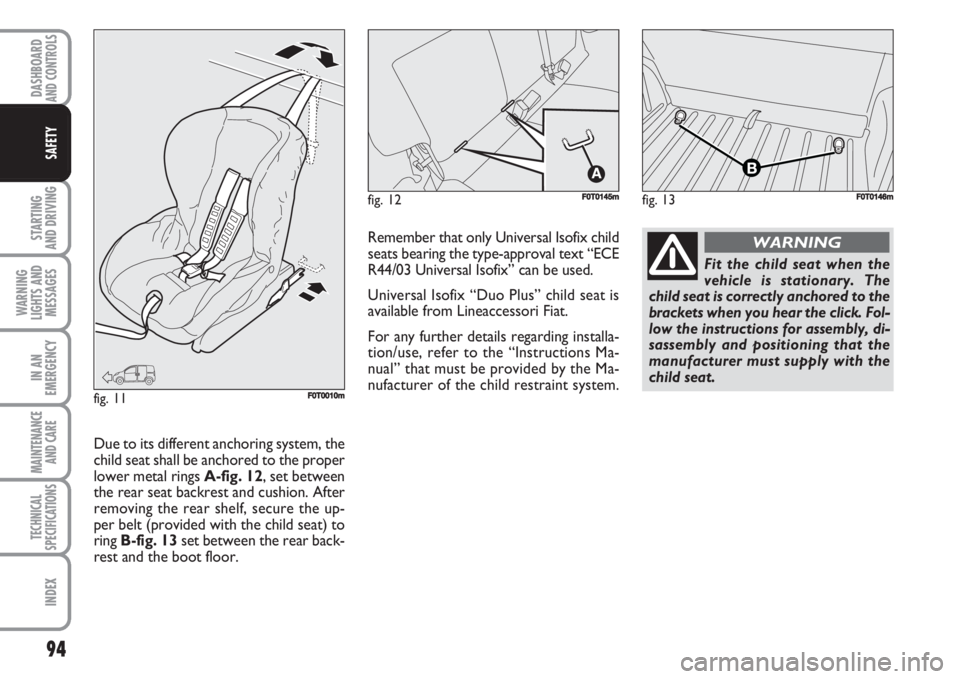
94
STARTING
AND DRIVING
WARNING
LIGHTS AND
MESSAGES
IN AN
EMERGENCY
MAINTENANCE
AND CARE
TECHNICAL
SPECIFICATIONS
INDEX
DASHBOARDAND CONTROLS
SAFETY
fig. 13FF0T0146mfig. 12F0T0145m
fig. 11F0T0010m
Fit the child seat when the
vehicle is stationary. The
child seat is correctly anchored to the
brackets when you hear the click. Fol-
low the instructions for assembly, di-
sassembly and positioning that the
manufacturer must supply with the
child seat.
WARNINGRemember that only Universal Isofix child
seats bearing the type-approval text “ECE
R44/03 Universal Isofix” can be used.
Universal Isofix “Duo Plus” child seat is
available from Lineaccessori Fiat.
For any further details regarding installa-
tion/use, refer to the “Instructions Ma-
nual” that must be provided by the Ma-
nufacturer of the child restraint system.
Due to its different anchoring system, the
child seat shall be anchored to the proper
lower metal rings A-fig. 12, set between
the rear seat backrest and cushion. After
removing the rear shelf, secure the up-
per belt (provided with the child seat) to
ring B-fig. 13set between the rear back-
rest and the boot floor.
Page 107 of 210
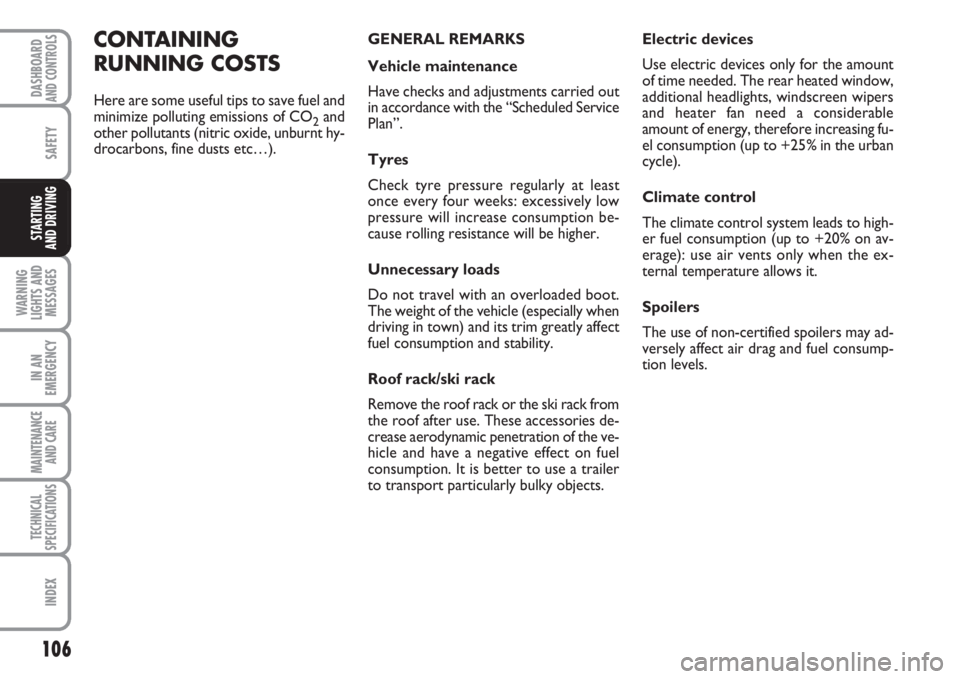
106
SAFETY
WARNING
LIGHTS AND
MESSAGES
IN AN
EMERGENCY
MAINTENANCE
AND CARE
TECHNICAL
SPECIFICATIONS
INDEX
DASHBOARDAND CONTROLS
STARTING
AND DRIVING
CONTAINING
RUNNING COSTS
Here are some useful tips to save fuel and
minimize polluting emissions of CO
2and
other pollutants (nitric oxide, unburnt hy-
drocarbons, fine dusts etc…).GENERAL REMARKS
Vehicle maintenance
Have checks and adjustments carried out
in accordance with the “Scheduled Service
Plan”.
Tyres
Check tyre pressure regularly at least
once every four weeks: excessively low
pressure will increase consumption be-
cause rolling resistance will be higher.
Unnecessary loads
Do not travel with an overloaded boot.
The weight of the vehicle (especially when
driving in town) and its trim greatly affect
fuel consumption and stability.
Roof rack/ski rack
Remove the roof rack or the ski rack from
the roof after use. These accessories de-
crease aerodynamic penetration of the ve-
hicle and have a negative effect on fuel
consumption. It is better to use a trailer
to transport particularly bulky objects.Electric devices
Use electric devices only for the amount
of time needed. The rear heated window,
additional headlights, windscreen wipers
and heater fan need a considerable
amount of energy, therefore increasing fu-
el consumption (up to +25% in the urban
cycle).
Climate control
The climate control system leads to high-
er fuel consumption (up to +20% on av-
erage): use air vents only when the ex-
ternal temperature allows it.
Spoilers
The use of non-certified spoilers may ad-
versely affect air drag and fuel consump-
tion levels.
Page 127 of 210
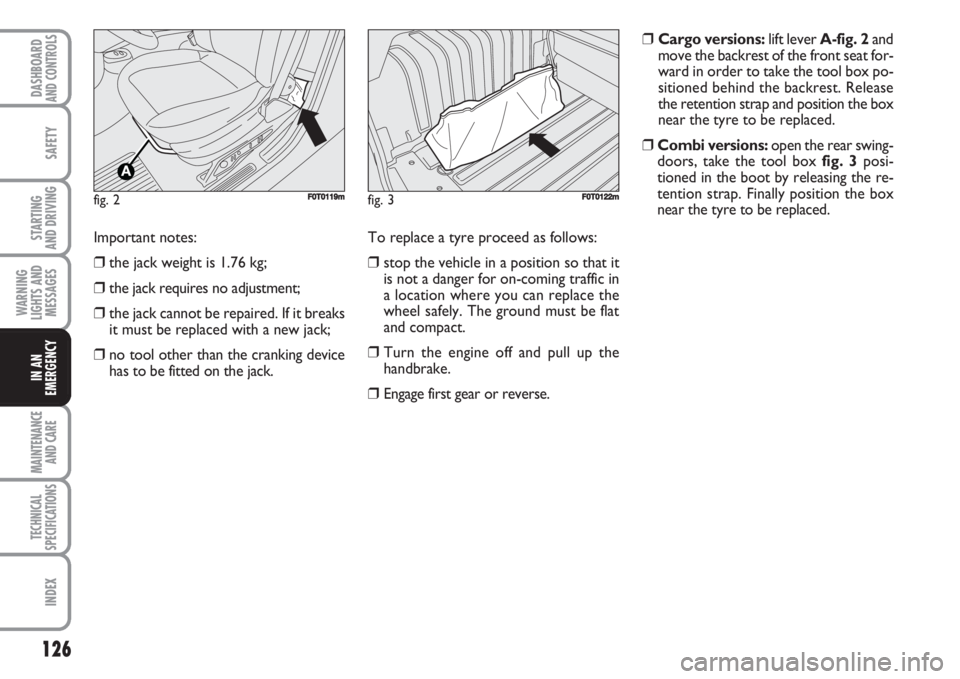
126
SAFETY
MAINTENANCE
AND CARE
TECHNICAL
SPECIFICATIONS
INDEX
DASHBOARDAND CONTROLS
STARTING
AND DRIVING
WARNING
LIGHTS AND
MESSAGES
IN AN
EMERGENCY
Important notes:
❒the jack weight is 1.76 kg;
❒the jack requires no adjustment;
❒the jack cannot be repaired. If it breaks
it must be replaced with a new jack;
❒no tool other than the cranking device
has to be fitted on the jack.To replace a tyre proceed as follows:
❒stop the vehicle in a position so that it
is not a danger for on-coming traffic in
a location where you can replace the
wheel safely. The ground must be flat
and compact.
❒Turn the engine off and pull up the
handbrake.
❒Engage first gear or reverse.
fig. 2F0T0119mfig. 3F0T0122m
❒Cargo versions:lift lever A-fig. 2and
move the backrest of the front seat for-
ward in order to take the tool box po-
sitioned behind the backrest. Release
the retention strap and position the box
near the tyre to be replaced.
❒Combi versions:open the rear swing-
doors, take the tool box fig. 3posi-
tioned in the boot by releasing the re-
tention strap. Finally position the box
near the tyre to be replaced.